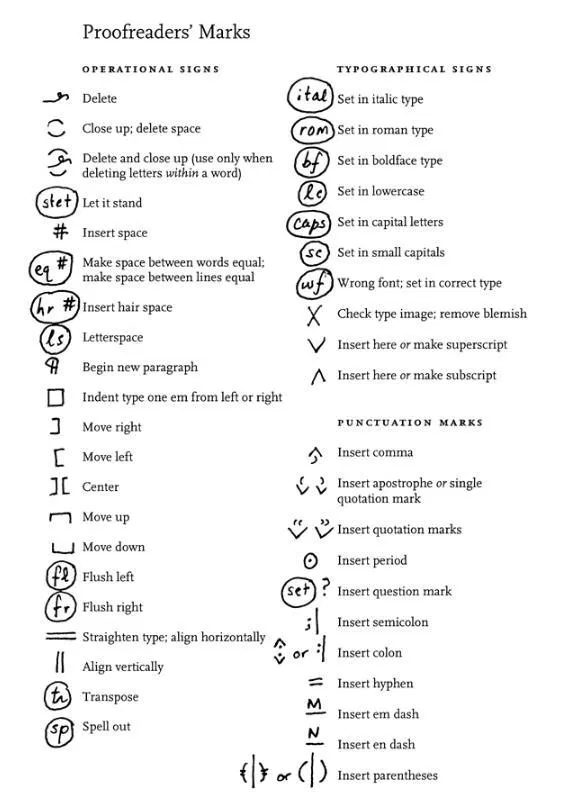# 标记语言
HTML(英语:HyperText Markup Language),中文译为超文本标记语言。从定义上看,HTML 首先是一种标记语言 (opens new window)。
标记语言,顾名思义,就是加了标记的语言。
语言是一种抽象的概念,引用维基百科的定义 (opens new window)——语言是一类复合交流系统。语言要实现交流的功能,必须通过一种媒介,语音、文字、手势等,都是语言的一种媒介。
在语音中,不同的声调可以表达不同的情感;在文字中,不同的格式亦可表达不同的情感——而格式则主要是通过标记来实现的。
# 传统出版
标记语言最早用于出版业,是作者、编辑及出版商之间用于描述作品的排版格式所使用的。在最早的出版流程中,作者将手稿交予编辑,编辑校对,通过标记订正文字、标点及格式,之后定稿、付印、发行。
传统的校对工作有自己的一套标记符号。下图是 The Chicogo Manual of Style (opens new window) 中的标记符号 (opens new window)及校对过的文稿 (opens new window):


对于下面的一段文字:
When you don’t create things, you become defined by your tastes rather than ability. Your tastes only narrow & exclude people. So create.
— why_the_lucky_stiff
其手稿形式为:

# 数字出版
到了数字出版 (opens new window)时代,由于计算机的广泛应用,学术界及工业界诞生了许多标记语言。HTML 作为 Web (opens new window) 的基石,毋庸置疑,是应用最广泛的标记语言。why_the_lucky_stiff 的文字,其 HTML 代码为:
<p>
When you don't create things, you become <em>defined</em> by your tastes
rather than ability. Your tastes only narrow & exclude people.
<strong>So create</strong>.
</p>
<p>— why_the_lucky_stiff</p>
学术界方面,为了应对复杂数学公式排版的挑战,Donald Knuth (opens new window) 教授在 1970 年代开发了 TeX (opens new window) 排版系统。 TeX 实现了细致的分页断行算法以及强大专业的数学排版功能,其数学排版能力在学术界得到了广泛使用。
比如,下面这段文字:
The quadratic formula is
其 TeX 代码为:
The quadratic formula is $-b \pm \sqrt{b^2 - 4ac} \over 2a$
why_the_lucky_stiff 的文字,其 TeX 代码为:
When you don't create things, you become \textit{defined} by your tastes rather than
ability. Your tastes only narrow & exclude people. \textbf{So create}.
— why_the_lucky_stiff
标记语言的可读性并不是特别好,特别是一些语法规则比较繁冗严格的标记语言中,标记可能会占据很大篇幅。比如,wikipedia上 关于 Typesetting 的第一段论述 (opens new window):

其纯文本 (opens new window)的字符数量是 574:
Typesetting is the composition of text by means of arranging physical types[1]
or the digital equivalents. Stored letters and other symbols (called sorts in
mechanical systems and glyphs in digital systems) are retrieved and ordered
according to a language's orthography for visual display. Typesetting requires
one or more fonts (which are widely but erroneously confused with and
substituted for typefaces). One significant effect of typesetting was that
authorship of works could be spotted more easily, making it difficult for
copiers who have not gained permission.[2]
而其 HTML 代码 (opens new window)的字符数量为 1289,在纯文本的基础上增加了 125% 的字符用于表达格式、链接及引用等:
<p>
<b>Typesetting</b> is the composition of
<a href="/wiki/Written_language" title="Written language">text</a> by means of
arranging physical
<a href="/wiki/Sort_(typesetting)" title="Sort (typesetting)">types</a>
<sup
id="cite_ref-typesetting_random_house_dictionary_definition_1-0"
class="reference"
><a href="#cite_note-typesetting_random_house_dictionary_definition-1">[1]</a>
</sup>
or the digital equivalents. Stored letters and other symbols (called
<a href="/wiki/Sort_(typesetting)" title="Sort (typesetting)">sorts</a> in
mechanical systems and
<a href="/wiki/Glyphs" class="mw-redirect" title="Glyphs">glyphs</a> in
digital systems) are retrieved and ordered according to a language's
<a href="/wiki/Orthography" title="Orthography">orthography</a> for visual
display. Typesetting requires one or more
<a href="/wiki/Font" title="Font">fonts</a> (which are widely but erroneously
confused with and substituted for
<a href="/wiki/Typeface" title="Typeface">typefaces</a>). One significant
effect of typesetting was that authorship of works could be spotted more
easily, making it difficult for copiers who have not gained permission.
<sup id="cite_ref-2" class="reference"><a href="#cite_note-2">[2]</a></sup>
</p>
为了解决一般标记语言冗长、难读难写的缺点,人们发明了各种各样的轻量级标记语言 (opens new window)。这其中应用最广泛的是由 Aaron Swartz (opens new window) 和 John Cruber (opens new window) 合作发明的 Markdown (opens new window) 。
Typesetting 论述 (opens new window) 的等效 Markdown 代码 (opens new window)为:
**Typesetting** is the composition of
[text](/wiki/Written_language "Written language") by means of arranging
physical [types](</wiki/Sort_(typesetting)> "Sort (typesetting)")
^[\[1\]](#cite_note-typesetting_random_house_dictionary_definition-1)^
or the digital equivalents. Stored letters and other symbols (called
[sorts](</wiki/Sort_(typesetting)> "Sort (typesetting)") in mechanical
systems and [glyphs](/wiki/Glyphs "Glyphs"){.mw-redirect} in digital
systems) are retrieved and ordered according to a language\'s
[orthography](/wiki/Orthography "Orthography") for visual display.
Typesetting requires one or more [fonts](/wiki/Font "Font") (which are
widely but erroneously confused with and substituted for
[typefaces](/wiki/Typeface "Typeface")). One significant effect of
typesetting was that authorship of works could be spotted more easily,
making it difficult for copiers who have not gained permission.
^[\[2\]](#cite_note-2)^
其字符数量为 939,在纯文本的基础上增加了 64% 的字符用于表达格式、链接及引用等。相较于 HTML,Markdown 增加的标记字符仅为 HTML 的一半,可见 Markdown 的标记更加紧凑。直观上看,Markdown 代码比 HTML 代码更“易读”一些。易读易写,这正是 Markdown 的设计目标之一。
作为引入 Markdown 的一个小结,why_the_lucky_stiff 的文字,其 Markdown 代码为:
When you don't create things, you become *defined* by your tastes rather than
ability. Your tastes only narrow & exclude people. **So create**.
— why_the_lucky_stiff
链接 →